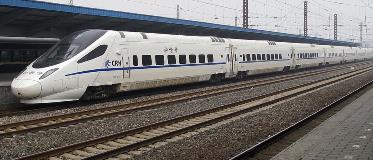Sectors to benefit from Indo-Japan bullet train project


Indian stock markets have rallied 23% (Nifty 50) and 21% (S&P BSE Sensex) in the first 8 months of FY17. Nifty 50 has crossed the 10,000 mark and Sensex surpassed 32,000 for the first time. It is an uphill task to identify stocks for investment in such a bullish market. One way to select stocks is to spot sectors that are likely to see an organic growth supported by concrete development plans/policies of the government.
Among the recent developments, Mumbai-Ahmedabad bullet train project in collaboration with Japan is a remarkable project. In this project, Japan will be the primary financier wherein it will fund 81% of the project cost at an interest rate of 0.1%; the overall cost is expected to be Rs 1.1 lakh crore. The project is expected to be completed by FY22.
On the basis of the above development, we believe Capital Goods, Metals, Infrastructure and Cement sectors to benefit the most from this project.
Capital Goods
Capital Goods sector is the backbone of the numerous manufacturing subsectors in the country such as Heavy Electrical Equipments, Power, Defense and Railways. The sector has seen 3.7% growth in FY17. Going forward, Capital Goods sector is expected to grow with the support of government initiatives like Make in India and bullet train project. Some of the stocks that are likely to benefit from bullet train project include:
BHEL - Government-owned BHEL, India’s largest power equipment manufacturer with 55% market share in the segment, is likely to play a major role in country’s bullet train project. BHEL and Japan-owned Kawasaki Heavy Industries have formed a joint venture to manufacture rolling stocks for the project. According to recent reports, the company is expected to manufacture the coaches at its Jhansi Plant in Uttar Pradesh or Bhopal in Madhya Pradesh. The company has an order backlog that stands at Rs 101,380 crore in Q1 FY18.
Siemens and ABB - These companies are expected to benefit from bullet trains as they manufacture electrification systems and high-speed rail traction. ABB derives ~25% of the total revenue from electrification products business.
Metals
India is the 3rd largest steel producer in FY17 with total production of finished steel at 83.01 million tonnes. Government is taking steps to improve the country's domestic steel sector and raise its capacity to 300 million tonnes (MT) by 2030-31. Pickup in domestic activity as well as commencement of developmental programs like construction of smart cities, bullet train etc will increase the demand for metals and related products. Some of the companies to benefit from the bullet train project include:
Tata Steel and JSW Steel - These stocks are likely to benefit from the project as it will increase the demand for commodities like steel, iron etc. JSW Steel is one of India’s largest private sector steel manufacturers with a capacity of 18mtpa followed by Tata Steel with an installed capacity of 10mtpa.
Infrastructure
The Government of India is highly focused on improving the rail and road connectivity in the country. Road Transport & Highways Ministry has invested around US$ 47.7 bn and Union Budget 2017 has further allocated Rs 131,000 crore for laying down 3,500 km of railway lines in 2017-18. Metro rail and bullet train project are the step towards developing urban infrastructure in the country. Some of the stocks to benefit from these initiatives:
NBBC- The company is likely to get new orders for development of new railway stations once the bullet train project is commissioned. The company recently got orders to develop 50 stations (10 stations in June 2017 and rest in September 2017). The company has a strong order book of Rs 75,000 crore in Q1 FY17 (90% from PMC and redevelopment segment, 10% from real estate and EPC division).
Larsen and Toubro Ltd - L&T offers services like construction of railway sidings and yards, bridges (steel and concrete), tunnels, rail-based urban transit systems (metro systems), stations (including underground stations), railway electrification, rolling stock, locomotives, intercity coaches, wagons and so on. The company has a total order book of Rs 262,900 cr as on Q1FY18.
Cement
India is the 2nd largest producer of cement in the world. It has a production capacity of 420 MT as on June 2017. The country has a lot of potential for development in the infrastructure and construction sectors and the cement sector is expected to largely benefit from it. Some government initiatives like smart cities and bullet train project will boost the demand for cement. Some of the companies to benefit are:
Ultratech Cement- It is the largest cement producer in India with a cement capacity of 95.3 MT (includes acquisition of the cement plants of JAL and JCCL- 21.2 MT and overseas operations). It has a market share of 22% on a pan-India basis and is the 4th largest player globally.
Some of the other cement companies to benefit from this project are ACC, Ambuja and Prism Cement.
ENDS
Start Investing in 5 mins*
Rs. 20 Flat Per Order | 0% Brokerage
